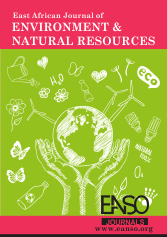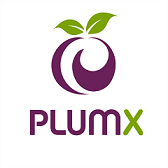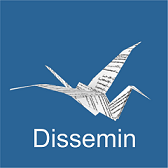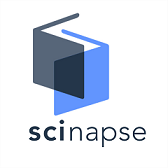An Evaluation of the Participation of the Affected Public in Environmental Impact Assessments (EIA) For Manufacturing and Processing Industries in the Central Region of Uganda
Abstract
Environmental impact assessment (EIA) was legally introduced in Uganda through the National Environment Act (NEA) 1995 (now NEA 2019) and made operational by the EIA Regulations 1998. Since the origin of EIA from the National Environment Policy Act of 1970 in the USA, public participation has taken an essential part of the EIA process. This paper assesses the legal provisions for public participation in the EIA process and the actual practice in Uganda, particularly the affected public. Data was collected using a literature review, survey questionnaire, interview guides and documentary analysis. The results indicated fairly good legal provisions for public participation and involvement in EIA. However, public participation was not well legislated in the early phases of the EIA process (preparation of project brief, screening, and scoping) and the later phases, particularly final decision-making and EIA follow-up. There were gaps between the law and the actual practice due to many contextual factors, including public participation, weak monitoring by the regulator, weak community cohesion and environmental stewardship, limited dissemination of EIA information and lack of community awareness of projects' potential environmental, social and health impacts. The study made recommendations to promote the participation of the affected public in the EIA process
Downloads
References
Akurut, M., Niwagaba, C. B., & Willems, P. (2017). Long-term variations of water quality in the Inner Murchison Bay, Lake Victoria. Environmental Monitoring and Assessment, 189(22). https://doi.org/10.1007/s10661-016-5730-4
Angus Morrison-Saunders, & Arts, J. (edits). (2004). Assessing Impacts. Handbook of EIA and SEA Follow - up. London. Earthscan Publications.
Banadda, E. N., Kansiime, F., Kigobe, M., Kizza, M., & Nhapi, I. (2009). Landuse-based nonpoint source pollution: A threat to water quality in Murchison Bay, Uganda. Water Policy, 11(SUPPL. 1), 94–105. https://doi.org/10.2166/wp.2009.106
Bateganya, N. L., Nakalanzi, D., & Babu, M. (2015). Buffering municipal wastewater pollution using urban wetlands in sub-Saharan Africa : a case of Masaka municipality , Uganda. Environmental Technology, 36(17), 2149–2160. https://doi.org/10.1080/09593330.2015.1023363
Biswal, R., Sinclair, A. J., & Spaling, H. (2023). Moving to next generation community-based environmental assessment. Impact Assessment and Project Appraisal, 00(00), 1–12. https://doi.org/10.1080/14615517.2023.2243019
Borioni, R., Gallardo, A. L. C. F., & Sánchez, L. E. (2017). Advancing scoping practice in environmental impact assessment: an examination of the Brazilian federal system. Impact Assessment and Project Appraisal, 35(3), 200– 213. https://doi.org/10.1080/14615517.2016.1271535
Edema, T., Karatu, K., & Edward, A. (2020). An evaluation of the environmental impact assessment practice in Uganda : challenges and opportunities for achieving sustainable development. Heliyon, 6(August), 1–11. https://doi.org/10.1016/j.heliyon.2020.e04758
Enríquez-de-Salamanca, Á. (2018). Stakeholders’ manipulation of Environmental Impact Assessment. Environmental Impact Assessment Review, 68, 10–18. https://doi.org/10.1016/j.eiar.2017.10.003
Faircheallaigh, C. O. (2010). Public participation and environmental impact assessment : Purposes , implications , and lessons for public policy making. Environmental Impact Assessment Review, 30(1), 19–27. https://doi.org/10.1016/j.eiar.2009.05.001
Gaber, J., & Gaber, J. (2019). Building “A Ladder of Citizen Participation.” Journal of the American Planning Association, 0(0), 1–14. https://doi.org/10.1080/01944363.2019.1612267
Glucker, A. N., Driessen, P. P. J., Kolhoff, A., & Runhaar, H. A. C. (2013a). Public participation in environmental impact assessment: Why, who and how? Environmental Impact Assessment Review, 43(January 2020), 104–111. https://doi.org/10.1016/j.eiar.2013.06.003
Glucker, A. N., Driessen, P. P. J., Kolhoff, A., & Runhaar, H. A. C. (2013b). Public participation in environmental impact assessment: Why, who and how? Environmental Impact Assessment Review, 43(November), 104–111. https://doi.org/10.1016/j.eiar.2013.06.003
The National Environment Act, 1995, Cap.153.
GoU. (1995). Constitution of the Republic of Uganda 1995.
IEA, I. &. (2006). Principles of environmental impact assessment, best practice, International Association for Impact Assessment (IAIA) and Institute of Environmental Assessment (IEA). U.K. http://scholar.google.com/scholar?hl=en&btnG=Search&q=intitle:PRINCIPLES+OF+ENVIRONMENTAL+IMPACT+ASSESSMENT+BEST+PRACTICE#4
Joseph, C., Gunton, T., & Rutherford, M. (2015). Good practices for environmental assessment. Impact Assessment and Project Appraisal, 33(4), 238– 254. https://doi.org/10.1080/14615517.2015.1063811
Kabenge, M., Wang, H., & Li, F. (2016). Urban eutrophication and its spurring conditions in the Murchison Bay of Lake Victoria. Environmental Science and Pollution Research, 23(1), 234–241. https://doi.org/10.1007/s11356-015-5675-0
Le Blanc, D. (2015). Towards Integration at Last? The Sustainable Development Goals as a Network of Targets. Sustainable Development, 23(3), 176–187. https://doi.org/10.1002/sd.1582
Luyiga, S., Haande, S., Semyalo, R. P., Kizito, Y. S., Miyingo-Kezimbira, A., Brettum, P., Solheim, A. L., Odong, R., Asio, S. M., Jensen, K. H., & Larsson, P. (2015). How water exchange and seasonality affect the eutrophication of Murchison Bay, Lake Victoria. Limnologica, 53, 60–73. https://doi.org/10.1016/j.limno.2015.06.001
Maes, M. J. A., Jones, K. E., Toledano, M. B., & Milligan, B. (2019). Mapping synergies and trade-offs between urban ecosystems and the sustainable development goals. Environmental Science and Policy, 93, 181–188. https://doi.org/10.1016/j.envsci.2018.12.010
Morgan, R. K. (2012). Environmental impact assessment: The state of the art. Impact Assessment and Project Appraisal, 30(1), 5–14. https://doi.org/10.1080/14615517.2012.661557
Morrison-Saunders, A. and Arts, J. (2023). Public Participation in Impact Assessment Follow-up. Special Publication Series No. 12. Fargo, USA: International Association for Impact Assessment., 12, 1– 3. https://www.canada.ca/en/impact- assessment- agency/services/policy-guidance/public-participation-impact-assessment-fact-sheet.html
Morrison-Saunders, A., Marshall, R., & Arts, J. (2007). EIA Follow-Up International Best Practice Principles. Special Publication Series No6. International Association for Impact Assessment, 6, 1–4. https://goo.gl/QRkFqZ
Nadeem, O., & Fischer, T. B. (2011). An evaluation framework for effective public participation in EIA in Pakistan. Environmental Impact Assessment Review, 31, 36–47. https://doi.org/10.1016/j.eiar.2010.01.003
Namuhani, N. (2015). Soil Contamination with Heavy Metals around Jinja Steel Rolling Mills in Jinja Municipality, Uganda. J Health Pollution, 9, 61–67.
NEMA. (1995). The National Environment Act, 1995 Cap 153.
NEMA. (1998). The Environmental Impact Assessment Regulation, Statutory Instrument No. 13/1998. (Issue Statutory Instrument No. 13).
Nilsson, M., Griggs, D., & Visbeck, M. (2016). Map the interactions between Sustainable Development Goals. Nature, 534(7607), 320–322. https://doi.org/10.1038/534320a
Oguttu, H. W., Bugenyi, F. W. B., Leuenberger, H., Wolf, M., & Bachofen, R. (2008). Pollution menacing Lake Victoria : Quantification of point sources around Jinja Town , Uganda. Water SA, 34(1), 89–98.
Paul, Walakira; James, O.-O. (2011). Impact of Industrial Effluents on Water Quality of Streams in Nakawa-Ntinda , Uganda. J. Appl. Sci. Environ. Manage, 15(2), 289–296.
Pierre, F., & Wondwosen, S. (2016). Assessment of the Environment Pollution and its impact on Economic Cooperation and Integration Initiatives of the IGAD Region ; National Environment Pollution Report – Ethiopia Framework Contract Beneficiaries 2013. Research Gate, April, 34. https://doi.org/10.13140/RG.2.1.2830.2480
Pinto, E., Morrison-Saunders, A., Bond, A., Pope, J., & Retief, F. (2019). Distilling and Applying Criteria for Best Practice EIA Follow-Up. Journal of Environmental Assessment Policy and Management, 21(2). https://doi.org/10.1142/S146433321950008X
Scheren, P. A. G. M., Zanting, H. A., & Lemmens, A. M. C. (2000). Estimation of water pollution sources in Lake Victoria, East Africa: Application and elaboration of the rapid assessment methodology. Journal of Environmental Management, 58(4), 235–248. https://doi.org/10.1006/jema.2000.0322
SPREP, & UNEP. (2016). Strengthening Environmental Impact Assessment: Guidelines for Pacific Island Countries and Territories. www.sprep.org
Stafford-Smith, M., Griggs, D., Gaffney, O., Ullah, F., Reyers, B., Kanie, N., Stigson, B., Shrivastava, P., Leach, M., & O’Connell, D. (2017). Integration: the key to implementing the Sustainable Development Goals. Sustainability Science, 12(6), 911–919. https://doi.org/10.1007/s11625-016-0383-3
Taako, G. E., Karatu, K., & Edward, A. (2020). An evaluation of the environmental impact assessment practice in Uganda : challenges and opportunities for achieving sustainable development. Heliyon, 6(July), e04758. https://doi.org/10.1016/j.heliyon.2020.e04758
UBOS. (2020). Uganda National Housing Survey 2019/2020, Kampala, Uganda: Uganda Bureau of Statistics. In Ubos. https://www.ubos.org/wp-content/uploads/publications/09_2021Uganda-National-Survey-Report-2019-2020.pdf
UNCST. (2014). National guidelines for research involving humans as research participants. In National guidelines for research involving humans as research participants (Issue July).
Wang, X., Rafa, M., Moyer, J. D., Li, J., Scheer, J., & Sutton, P. (2019). Estimation and mapping of sub-national GDP in Uganda using NPP-VIIRS imagery. Remote Sens., 11(2), 1–14. https://doi.org/10.3390/rs11020163
Zuhair, M. H., & Kurian, P. A. (2016). Socio-economic and political barriers to public participation in EIA: implications for sustainable development in the Maldives. Impact Assessment and Project Appraisal, 34(2), 129– 142. https://doi.org/10.1080/14615517.2016.1176404
Copyright (c) 2023 George Edema Taako, Edward Andama, PhD, James Karatu Kiemo, PhD

This work is licensed under a Creative Commons Attribution 4.0 International License.




























